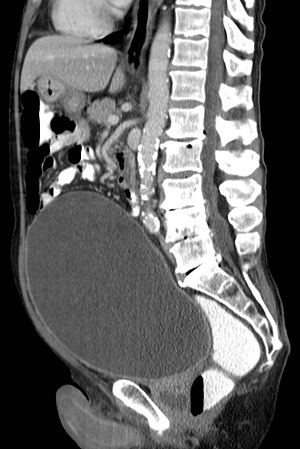Overflow incontinence
| Overflow incontinence | |
|---|---|
| Other names | ischuria paradoxa |
 | |
| CT scan in the sagittal plane which reveals a greatly enlarged urinary bladder caused by urinary retention, a condition which often leads to overflow incontinence. | |
| Specialty | Urology |
Overflow incontinence is a form of urinary incontinence, characterized by the involuntary release of urine from an overfull urinary bladder, often in the absence of any urge to urinate. This condition occurs in people who have a blockage of the bladder outlet (benign prostatic hyperplasia, prostate cancer, or narrowing of the urethra), or when the muscle that expels urine from the bladder is too weak to empty the bladder normally. Overflow incontinence may also be a side effect of certain medications.
Causes[]
Lesions affecting sacral segments or peripheral autonomic fibres result in atonic bladder with loss of sphincteric coordination. This results in loss of detrusor contraction, difficulty in initiating micturition and overflow incontinence. Anticholinergic side effects of certain medications (for example, certain antipsychotics and antidepressants) may cause urinary retention which may lead to overflow incontinence. Alpha-adrenergic agonists may cause urinary retention by stimulating the contraction of the urethral sphincter. Calcium channel blockers may decrease the contractility of the smooth muscle tissue in the urinary bladder, causing urinary retention with overflow incontinence.[1] Epidural anesthesia and delivery also can cause the overflow incontinence.
Pathophysiology[]
Overflow incontinence occurs when the patient's bladder is always full so that it frequently leaks urine. Weak bladder muscles, resulting in incomplete emptying of the bladder, or a blocked urethra can cause this type of incontinence. Autonomic neuropathy from diabetes or other diseases (e.g. Multiple sclerosis) can decrease neural signals from the bladder (allowing for overfilling) and may also decrease the expulsion of urine by the detrusor muscle (allowing for urinary retention). Additionally, tumors and kidney stones can block the urethra. Spinal cord injuries or nervous system disorders are additional causes of overflow incontinence. In men, benign prostatic hyperplasia (BPH) may also restrict the flow of urine. Overflow incontinence is rare in women, although sometimes it is caused by fibroid or ovarian tumors. Also overflow incontinence can be from increased outlet resistance from advanced vaginal prolapse causing a "kink" in the urethra or after an anti-incontinence procedure which has overcorrected the problem.[2] Early symptoms include a hesitant or slow stream of urine during voluntary urination. Anticholinergic and NSAIDs medications may worsen overflow incontinence.
Diagnosis[]
The gold standard for all urinary incontinence is an urodynamic study that looks for bladder capacity, detrusor stability, contractility, and voiding ability (cystometry).
Management[]
- Medications
Bethanechol (Management of overflow incontinence by activating muscarinic receptors in the bladder and stimulating contraction to void the urine, NOT a treatment modality; must rule out urinary obstruction prior to use.)
- Surgery
- Catheterization
If an incontinence is due to overflow incontinence, in which the bladder never empties completely, or if the bladder cannot empty because of poor muscle tone, past surgery, or spinal cord injury, a catheter may be used to empty the bladder. A catheter is a tube that can be inserted through the urethra into the bladder to drain urine. Catheters may be used once in a while or on a constant basis, in which case the tube connects to a bag that is attached to the leg. If a long-term (or indwelling) catheter is used, urinary tract infections may occur.
See also[]
References[]
- ^ Vasavada SP, Carmel ME, Rackley R (2012). "Urinary incontinence". Medscape. New York: WebMD. Retrieved 2012-07-28.
- ^ Christopher M. Tarnay, MD & Narender N. Bhatia, MD (2006). "Overflow Incontinence". Urinary Incontinence - Overview. . Retrieved 2006-12-20.
External links[]
- Urinary incontinence